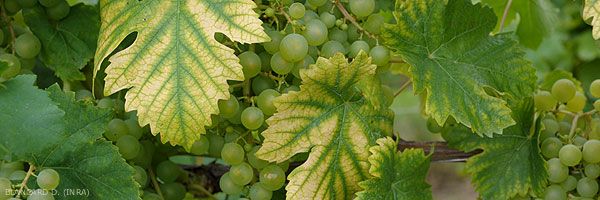
Nutritional disorders
Like many cultivated plants, the vine needs a variety of mineral elements to ensure its growth throughout its development cycle. Its fertilization is not always easy to manage. In addition, it can be influenced by various parameters:
- the richness and balance of the soil in fertilizing elements (soil analyzes are therefore essential);
- the cultivated grape variety and rootstock;
- planting density;
- the nature of the soil;
- the mode of production;
- and any other factor disrupting plant growth.
Faced with this situation, it is not unlikely to be confronted in the field with plants suffering from deficiencies or excess of nutrients. These conditions are classified under “Abiotic or non-parasitic diseases” and grouped together under the terminology “Nutritional disorders”. The latter appear quite frequently on vines by discolorations and deformations, especially on the leaves, of variable nature and distribution on the plants.
Remember that currently when we talk about deficiency, we often tend to equate true deficiencies with induced deficiencies.
The real deficiencies occur when one or more are too little in the soil; most of them are currently quite rare. Their diagnosis visual is very difficult because, with some exceptions, the symptoms they cause are materialized by discolorations, yellowing or reddening of the leaves more or less intense, sometimes difficult to assess by a non-specialist.
The deficiencies induced arise when the element present in sufficient amounts are not comparable for several reasons. In this case, they should be specified. This could be due, for example, to a lack of water, to asphyxiation, to an inappropriate pH of the soil, to abnormally excessive temperatures ...
When you are faced with this type of symptom, do not too hastily conclude that there is any deficiency without talking to your technician or consulting a specialist . Of course, in addition to these opinions, physical and chemical analyzes of the soil and vegetation are required.
| Deficiencies | Symptoms | context Agronomic of expression |
| Calcium (Ca ++) |
Sagging of internal tissues (cambium, parenchyma ...) leading to the collapse of the herbaceous parts of the plant. Leaves : Yellowing of the periphery of the blade which curves towards the underside, necrosis and shows a jagged appearance. Roots : decrease in growth and change in consistency which becomes gelatinous. |
Leached floors |
| Magnesium (Mg++) |
Leaves : interveinal discoloration of leaves beginning at the periphery of the blade. On black grape varieties, the discoloration changes from yellow to orange, then to red (figures 1 and 2). For white grape varieties, the leaves turn yellow (Figures 3 and 4). The discolored tissue eventually necroses gradually from the petiole. This deficiency manifests itself first on older leaves. |
Light soils, poor in humus, too much potassium fertilizer input |
| Azote (N) |
Reduction in the vigor and vitality of the strains. Leaves : discoloration of the blade varying from yellow to red-orange depending on the grape variety (figure 5). Falling leaves. Roots : early maturity, quite premature. Berries : reduction in ripening and quantity. |
Limestone soils
|
| Potassium (K) |
Leaves : reduced growth, contour of the blade less indented and appearance smooth, shiny and slightly raised. Presence of small brown lesions on the part exposed to the sun, with irregular contours. Diffuse inter-vein discoloration of the leaf blade (with a yellow or red tint depending on the grape variety) (Figures 6 and 7). Necrosis and dryness of the limbus and defoliation in severe cases of K deficiency. Roots : poor growth of the branches, and reduced productivity of the vine. |
Light, sandy soils rich in ions |
| Sulfur (S) |
Decreased vine growth. Leaves : yellowing of the blade. |
|
| Phosphorus (P) |
Leaves : accumulation of anthocyanins in the petioles and veins which take on a purplish tint, while the blade becomes darker. Modification of plant habit and premature defoliation (figure 8). Berries : decrease in size and number of berries. |
Sandy and acidic soils |
| Manganese (Mn) |
Leaves : interveinal mottled yellowing (figure 9), veins appearing more prominent. Bunches : smaller with incomplete maturity. |
Alkaline soils at pH ≥ 7 |
| Zinc (Zn) |
Leaves : small, asymmetrical, and palmette-shaped with an open petiolar sinus. The petioles are unusually short and large. Bushy foliage. Twigs : the merithalles or internodes are shorter, flattened and more numerous. Berries : manifestation of coulure and millerandage. |
Calcareous soils, and excess phosphate fertilization |
| Bore (B) |
Leaves : diffuse discoloration of the blade which turns white-yellow on white varieties, and reddish on black varieties. The blade necroses in spots between the veins and on the periphery. It is also blistered, thicker and leathery in young leaves. Twigs : weak growth with shorter merithalles. Presence of numerous zig zag ramifications. Appearance of protuberance on diseased twigs that don't taste well, especially at their upper extremity. Inflorescences : withering and millerandage. Berries : soft in consistency and dirty green in color; their film has a wrinkled appearance. |
Gravelly soils (containing gravel)
|





